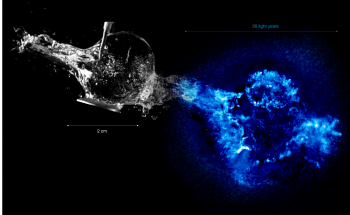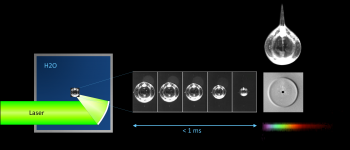Editor’s note: this is an extended version of an original article which was published here.
The researchers at the École Polytechnique Fédérale de Lausanne in Switzerland are trying to create the perfect bubble in weightlessness. By making parabolic flights, they are able to create a zero gravity environment and in this environment their experiment begins.
The researchers are trying to understand a process called ‘cavitation’ which can occur when a spacecraft leaves Earth’s gravity.
Liquids, in a general sense, maintain their state due to the pressure of gravity (and some additional factors such as temperature). The impact of gravity, however, is quite extreme. Consider this: water boils much faster at the top of a large mountain. Why is that?

Comparison of the shape and size of a bubble formed in weightlessness vs. a supernova. Credit: ESA/P.Kobel
The same amount of energy, heat, is expended to reach boiling point. How is it that the water turns into a vapour so much faster? The answer is gravity. Generally gravity pushes on the water and this keeps it in shape. It’s this very gravity that researchers are escaping with their experiments.
So why do we need to experiment with zero gravity?
We must come back to cavitation. Cavitation produces bubbles. This is where, without the forces of gravity, liquids begin to change state and bubbles are formed. These bubbles don’t necessarily stay put though. The bubbles pop. During the very fast and violent collapse of cavitation bubbles, their energy is expelled in jets and shocks, which can cause wear and tear in industrial machines and rocket fuel pumps.
On Earth, gravity pushes and pulls liquids, turning round bubbles into ‘egg’ shapes. Parabolic flights allow researchers to escape gravity for around 20 seconds at a time in special aircraft performing rollercoaster-like parabolic manoeuvres.
The team from École Polytechnique Fédérale focus lasers on pure water and capture the bubbles on camera as they form and implode in a matter of lmilliseconds.
The video below captures that process.
There is positive potential in the bubbles too. Harnessing the energy that liquid bubbles give off as they implode could be a novel source of energy in the future.
One example that researchers are exploring is producing very localised heat on demand by creating and imploding bubbles with ultrasound. This technique could activate heat-sensitive drugs in the future, turning them on in very specific parts of your body, to make sure they work where needed most.
Visit the team’s website for more information



Discussion: no comments